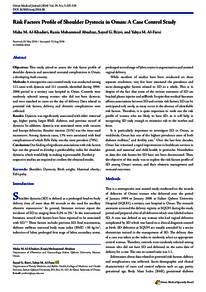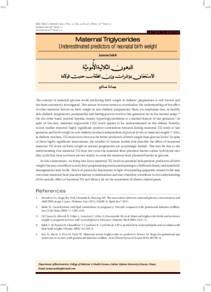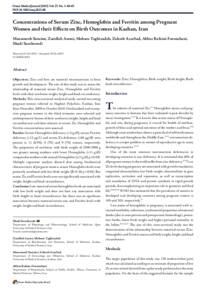Document
Risk factors profile of shoulder dystocia in Oman : a case control study.
Identifier
DOI 10.5001/omj.2014.88
Contributors
Publisher
Oman Medical Specialty Board.
Gregorian
2014-09
Language
English
English abstract
Objective:This study aimed to assess the risk factor profile of shoulder dystocia and associated neonatal complications in Oman, a developing Arab country.
Methods:A retrospective case-control study was conducted among 111 cases with dystocia and 111 controls, identified during1994-2006period in a tertiary care hospital in Oman. Controls were randomly selected among women who did not havedystocia,and were matched to cases on the day of delivery. Data related to potential risk factors, delivery, and obstetric complications were collected.
Results:Dystocia was significantly associated with older maternal age, higher parity, larger BMI, diabetes, andpreviousrecord of dystocia. In addition, dystocia was associated more with vacuum and forceps deliveries. Routine traction (51%) was the most usedmanoeuvre. Among dystocia cases, 13% were associated with fetal complications of which Erb's Palsy was the most prevalent (79%).
Conclusion:Our finding of significant associations with risk factors lays out the ground to develop a predictability index for shoulder dystocia, which would help in making it preventable. Further prospective studies are required to confirm the obtained results.
Member of
Resource URL
Citation
Al-Khaduriyah, Maha M., Abudraz, Rania Mohammed, Rizvi, Syed Gauhar A., & Al-Farsi, Yahya M. (2014). Risk factors profile of shoulder dystocia in Oman : a case control study. Oman Medical Journal, 29 (5), 325-329.
Category
Journal articles



